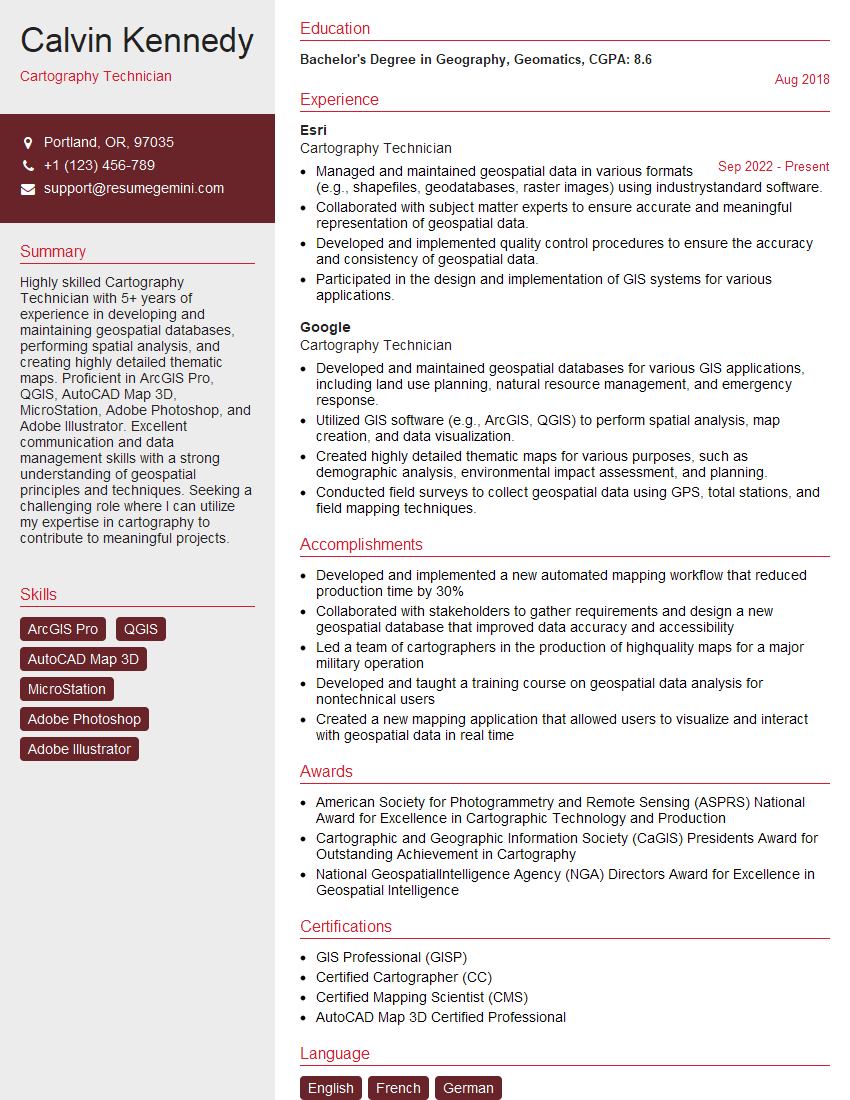Are you a seasoned Cartography Technician seeking a new career path? Discover our professionally built Cartography Technician Resume Template. This time-saving tool provides a solid foundation for your job search. Simply click “Edit Resume” to customize it with your unique experiences and achievements. Customize fonts and colors to match your personal style and increase your chances of landing your dream job. Explore more Resume Templates for additional options.

Calvin Kennedy
Cartography Technician
Summary
Highly skilled Cartography Technician with 5+ years of experience in developing and maintaining geospatial databases, performing spatial analysis, and creating highly detailed thematic maps. Proficient in ArcGIS Pro, QGIS, AutoCAD Map 3D, MicroStation, Adobe Photoshop, and Adobe Illustrator. Excellent communication and data management skills with a strong understanding of geospatial principles and techniques. Seeking a challenging role where I can utilize my expertise in cartography to contribute to meaningful projects.
Education
Bachelor’s Degree in Geography, Geomatics
August 2018
Skills
- ArcGIS Pro
- QGIS
- AutoCAD Map 3D
- MicroStation
- Adobe Photoshop
- Adobe Illustrator
Work Experience
Cartography Technician
- Managed and maintained geospatial data in various formats (e.g., shapefiles, geodatabases, raster images) using industrystandard software.
- Collaborated with subject matter experts to ensure accurate and meaningful representation of geospatial data.
- Developed and implemented quality control procedures to ensure the accuracy and consistency of geospatial data.
- Participated in the design and implementation of GIS systems for various applications.
Cartography Technician
- Developed and maintained geospatial databases for various GIS applications, including land use planning, natural resource management, and emergency response.
- Utilized GIS software (e.g., ArcGIS, QGIS) to perform spatial analysis, map creation, and data visualization.
- Created highly detailed thematic maps for various purposes, such as demographic analysis, environmental impact assessment, and planning.
- Conducted field surveys to collect geospatial data using GPS, total stations, and field mapping techniques.
Accomplishments
- Developed and implemented a new automated mapping workflow that reduced production time by 30%
- Collaborated with stakeholders to gather requirements and design a new geospatial database that improved data accuracy and accessibility
- Led a team of cartographers in the production of highquality maps for a major military operation
- Developed and taught a training course on geospatial data analysis for nontechnical users
- Created a new mapping application that allowed users to visualize and interact with geospatial data in real time
Awards
- American Society for Photogrammetry and Remote Sensing (ASPRS) National Award for Excellence in Cartographic Technology and Production
- Cartographic and Geographic Information Society (CaGIS) Presidents Award for Outstanding Achievement in Cartography
- National GeospatialIntelligence Agency (NGA) Directors Award for Excellence in Geospatial Intelligence
Certificates
- GIS Professional (GISP)
- Certified Cartographer (CC)
- Certified Mapping Scientist (CMS)
- AutoCAD Map 3D Certified Professional
Career Expert Tips:
- Select the ideal resume template to showcase your professional experience effectively.
- Master the art of resume writing to highlight your unique qualifications and achievements.
- Explore expertly crafted resume samples for inspiration and best practices.
- Build your best resume for free this new year with ResumeGemini. Enjoy exclusive discounts on ATS optimized resume templates.
How To Write Resume For Cartography Technician
- Highlight your technical skills in GIS software, such as ArcGIS Pro, QGIS, and AutoCAD Map 3D.
- Showcase your ability to create visually appealing and informative maps.
- Emphasize your experience in collecting and managing geospatial data.
- Quantify your accomplishments whenever possible, using specific metrics to demonstrate the impact of your work.
- Network with professionals in the field and attend industry events to stay up-to-date on the latest trends and technologies.
Essential Experience Highlights for a Strong Cartography Technician Resume
- Developed and maintained geospatial databases for various GIS applications, including land use planning, natural resource management, and emergency response.
- Utilized GIS software (e.g., ArcGIS, QGIS) to perform spatial analysis, map creation, and data visualization.
- Created highly detailed thematic maps for various purposes, such as demographic analysis, environmental impact assessment, and planning.
- Conducted field surveys to collect geospatial data using GPS, total stations, and field mapping techniques.
- Managed and maintained geospatial data in various formats (e.g., shapefiles, geodatabases, raster images) using industry-standard software.
- Collaborated with subject matter experts to ensure accurate and meaningful representation of geospatial data.
- Developed and implemented quality control procedures to ensure the accuracy and consistency of geospatial data.
Frequently Asked Questions (FAQ’s) For Cartography Technician
What are the key skills required for a Cartography Technician?
Key skills include proficiency in GIS software, experience in data collection and management, map creation, and a strong understanding of geospatial principles.
What is the job outlook for Cartography Technicians?
The job outlook is expected to grow faster than average due to the increasing demand for geospatial data in various industries.
What are the career advancement opportunities for a Cartography Technician?
Advancement opportunities include roles such as GIS Analyst, GIS Manager, or Geospatial Data Scientist.
What is the average salary for a Cartography Technician?
The average salary varies depending on experience, location, and industry, but typically ranges from $50,000 to $80,000 per year.
What are the educational requirements for a Cartography Technician?
Most Cartography Technicians have a Bachelor’s degree in Geography, Geomatics, or a related field.
What is the difference between a Cartographer and a Cartography Technician?
Cartographers typically have a higher level of education and are responsible for the design and creation of maps, while Cartography Technicians assist in the production and maintenance of geospatial data.
What are the best ways to prepare for a career as a Cartography Technician?
Gain hands-on experience with GIS software, develop strong data management skills, and network with professionals in the field.